

Consolarium blog
When we first began the Consolarium initiative way back in 2006 its main aim was to explore and share ways in which the use of computer games and game design could have a positive impact on teaching and learning and support Curriculum for Excellence in Scottish schools. Over the years this aim has remained the same and our reach across the country has been quite a success. Many of the ideas, approaches and methodologies we employed as well as many of the challenges that we faced in growing this practice became of interest to educational colleagues in England and further afield and this led to a number of invitations to speak at many conferences and other professional development settings. This wider recognition from colleagues outwith Scotland has played some part in affirming Learning and Teaching Scotland’s (now Education Scotland) ambitious and somewhat prescient decision to invest in and commit to such a venture back in 2006.
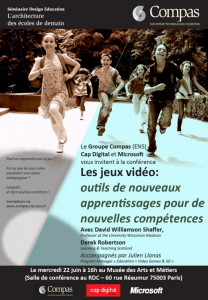 One of the invites that we were able to accept and honour recently was from the Digital City events (part of the Futur en Seine Festival) in Paris. As part of a three part seminar programme organized by Le Group Compas, Cap-Digital and Microsoft we were asked to deliver a keynote talk about our work in leading game based learning in Scotland and also about what we have seen in terms of impact on learning.
One of the invites that we were able to accept and honour recently was from the Digital City events (part of the Futur en Seine Festival) in Paris. As part of a three part seminar programme organized by Le Group Compas, Cap-Digital and Microsoft we were asked to deliver a keynote talk about our work in leading game based learning in Scotland and also about what we have seen in terms of impact on learning.
The session was to be shared with Professor David Shaffer from Wisconsin University. Prof. Shaffer is the author of How Computer Games Help Children Learn and he is the person behind the Epistemic Games website. It was a delight to share the session with such an eminent GBL leader and as it turned out although we shared the same belief that games can help children learn, how we should go about this was slightly different…
Our main thrust in relation to games in schools has been to use commercially available games (COTS) that have been built for entertainment and not for education. Our reasoning behind this is embedded in James Paul Gee’s take on Semiotic Domains and the fact that so many computer games present challenging, demanding, complex and culturally appealing contexts for learning that schools can undoubtedly employ to great effect. Some examples include using these games in schools:
We have also worked closely and carefully with our Local Authority Education partners and schools in Scotland to ensure that our endeavours are always wholly based in sound pedagogic principles that would fit in with the established practices and workings of a classroom to some degree but that would also begin to challenge established mindsets regarding the nature of technology in learning, valuing and exploiting what children value in their own cultural domains and how effective learners can be independent of adult intervention.
Prof. Shaffer’s work with Epistemic Games focuses more on making bespoke games that would enable players to be professional people. This definition of Epistemic Games is offered on his website:
Epistemic games are computer games that can help players learn to think like engineers, urban planners, journalists, lawyers, and other innovative professionals, giving them the tools they need for a changing world.
In epistemic games, players see what it is like to live in the world of adults. They learn ways of thinking that matter in the digital age, and have a chance to imagine the kind of person they might someday become.
In essence Epistemic games such as Nephrotex, Urban Science, Digital Zoo and Sodaconstructor are designed in such a way that to play successfully the player has to situate themselves within the real life context of the job of being an engineer, urban planner or animator thus learning about AND applying the skills directly related to these positions.
Prof. Shaffer established a thread through his presentation that questioned the effectiveness of schooling in respect of learning being detached from the context of application of newly found and developing skills, knowledge and understanding. School needed to change to help learners reach their full potential and the application of Epistemic Games should be central to that change.
Both our presentations plus an introduction to the session from Julien Llanas, who chaired the session, can be viewed here.
The discussion session at the end of our presentations was particularly lively with an emphasis on some of what we had touched on in relation to metacognition, development of self-esteem and enhanced attitudes to being a learner and learning. Professor Daniel Andler from the University of Paris-Sorbonne was tasked with summing up the seminar session. As part of this summing up Professor Andler chose to focus on the different approaches that Prof. Shaffer and his team have taken. He compared us to the Mensheviks and the Bolsheviks with the Consolarium being observed to be the more moderate of the two in relation to trying to effect change from within established structures and attitudes but with Dr Shaffer looking for educational revolution on a much quicker scale!
Yet again it was a great delight to be able to share the vision and the innovative practice coming from of Scottish schools with colleagues in another country. We look forward to hearing how people such as Julien Llanas and other interested parties that we met in Paris make progress in the domain of game based learning In French schools as well as learning more about the work of the team at Epistemic Games.
MoreOn the last Tuesday of the term, I was able to talk with pupils from Loriston and Kirkhill primary schools over Glow Meet about their P7-S1 transition project. Along with Charleston and Abbotswell primary schools, all primary 7 pupils studied Healthy Living as the basis of a transition project to Kincorth Academy. This is a little taster of what went on during the project. You will be able to find out more at SLF 2011 on Thursday 22 September, 1.15pm at this seminar.
Using a dedicated glow group, pupils from all schools were asked to design and upload a flyer to promote healthy living to a document store. All pupils had access to these stores and were encouraged to look at others work and leave comments. However, flyers were not the only media that the pupils created and shared.
My ex Consolarium colleague, Charlie Love, spent time with all 4 primary schools, giving them all an overview and a few lessons on using Scratch to create games. They also used the tutorials available in the Consolarium Glow Group, as well as looked at remixing projects from the Scratch website.
The pupils were incredibly motivated and challenged by the this activity and they told me in the meeting that while it was hard to do the programming, they worked through the problems as groups. If they couldn’t find a solution, they used a forum within Glow to ask for help / get feedback from their classmates / peers in another school / a teacher.
These games were also uploaded to the Glow group for feedback from other schools. One of the boys in Kirkhill primary school told me that the feedback he got back via glow helped him make his game more playable. This was echoed by pupils at Loriston primary school.
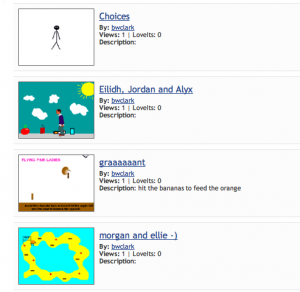 All pupils found the the online community a valuable source of help and feedback, but would of liked to have Mr Love there in person more often to help out with any problems they had. However, by not having he expert on hand, meant the the pupils did have to seek alternative help. As well as the online Glow community, in many cases, some pupils who really got into the game design / scratch projects, became the in-class expert that many pupils turned to for help.
All pupils found the the online community a valuable source of help and feedback, but would of liked to have Mr Love there in person more often to help out with any problems they had. However, by not having he expert on hand, meant the the pupils did have to seek alternative help. As well as the online Glow community, in many cases, some pupils who really got into the game design / scratch projects, became the in-class expert that many pupils turned to for help.
You can play some of the games online at the Scratch website here, or, if you have a Glow account, visit the glow group and see all games and flyers here.
Within the group, pupils from P7 and the secondary schools were encouraged to use a forum to discuss any questions / fears they may have about coming up to the Academy as well as seek help with their Scratch Projects.
You can find out more about this transition project, its links to CfE, use of Glow and their first experience of Game Design at SLF 2011 - sign up here.
More
I met Fraser Christie, PT Computing at Braeview Academy in Dundee, at a game design CPD event we held a few months ago. During the event, we started talking about various aspects of technology, computing and CfE in the classroom and got on to the subject of Arduino. I have previously written about Arduino here. After our discussion, Fraser expressed an interest in trying out the rapid prototyping toolkit in his school. I managed to send up a few kits from the Consolarium up to the school and last week I managed to grab a few minutes with an S2 pupil, Paul, who had been using the Arduino kits at lunchtime and after school.
 Paul quickly gave me a demonstration of the Arduino toolkit and managed to very quickly create a simple circuit. During his demonstration, Paul clearly demonstrated a firm understanding of electrical components their purpose. The video also demonstrates the possibility of using Arduino kits to address some for the science experiences and outcomes, such as SCN 4-09c : ‘engineer an electronic system to provide a practical solution to a real-life situation’ and others within the Electricity E’s and O’s.
Paul quickly gave me a demonstration of the Arduino toolkit and managed to very quickly create a simple circuit. During his demonstration, Paul clearly demonstrated a firm understanding of electrical components their purpose. The video also demonstrates the possibility of using Arduino kits to address some for the science experiences and outcomes, such as SCN 4-09c : ‘engineer an electronic system to provide a practical solution to a real-life situation’ and others within the Electricity E’s and O’s.
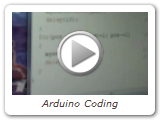 Paul later demonstrated how the Arduino can be programmed using the Processing progamming language - again, demonstrating an understanding of the code, in this case, how to change the speed of a servo. This has significant links to the Computing E’s and O’s, in particular TCH 4-09a - ‘By learning the basic principles of a programming language or control technology, I can design a solution to a scenario, implement it and evaluate its success’.
Paul later demonstrated how the Arduino can be programmed using the Processing progamming language - again, demonstrating an understanding of the code, in this case, how to change the speed of a servo. This has significant links to the Computing E’s and O’s, in particular TCH 4-09a - ‘By learning the basic principles of a programming language or control technology, I can design a solution to a scenario, implement it and evaluate its success’.
Paul is obviously interested in electronics and computing, and makes a number of references to using online videos to develop his understanding of the circuit making and coding, all in his own time, taking responsibility for his learning. At the end of this video, Paul talks about building a real device - a hidden gumball machine and goes on to talk about the need to not only design/build the circuit and create the program, but to physically build the housing for the device. Within a school context, this could offer links with Design and Technology in order to physically build the object.
I spoke with Fraser after Paul had left us, and he talked about his hopes for the Arduino kits in school for next term. Already he has a rising number interested pupils like Paul who are keen to get hands on with the kits at lunchtimes and after schools, but he intends to use the Arduino kits with his 15 Advanced Higher Computing pupils (pupils are from various schools, but being hosted at Braeview next session) and hopes to inspire them to use the technology as part of their AH projects. He has also made connections with Dundee University and is hoping to work with them next session in order to develop Arduino in school.
![]() It is also worth noting that if delving into the processing programming language seems a bit too much at the start, then there is an alternative. Using the Scratch application framework, the folks over at Citilab have created S4A - Scratch for Arduino. This allows user to use a Scratch like environment to program the Arduino.
It is also worth noting that if delving into the processing programming language seems a bit too much at the start, then there is an alternative. Using the Scratch application framework, the folks over at Citilab have created S4A - Scratch for Arduino. This allows user to use a Scratch like environment to program the Arduino.
 Many of the CPD opportunities Charlie Love and myself have offered over the last 18 months have been based on using Scratch to engage learners and teachers with some hands on game design activities. Particularly in primary schools. However, is difficult to work with ALL the schools we are invited to. Enter GlowTV….
Many of the CPD opportunities Charlie Love and myself have offered over the last 18 months have been based on using Scratch to engage learners and teachers with some hands on game design activities. Particularly in primary schools. However, is difficult to work with ALL the schools we are invited to. Enter GlowTV….
GlowTV
At 11am on Wednesday 22nd June, we will be running an online workshop on game design with Scratch via GlowTV. This session is an introduction to Scratch for creating games and will take you through the Scratch interface and simple programming. During the broadcast we will make a fully working game. You will be amazed at what you can do in so little time! Ideally suited for CfE levels 2 and 3 for both staff and pupils. You can watch the broadcast and build the game along with it if you want.
Support materials for the game we will make on the day will be available via the Consolarium glow group for use during and after. More details on this early next week.
You will also be able to ask questions during the session and we will try and answer them for you.
Get Involved!
1. Sign up for GlowTV
2. Register for the session - make sure to use the hashtag #glowtv3
3. If you want to build the game along with the broadcast, you will need Scratch installed on your computer. Download Scratch here for free from http://scratch.mit.edu
We are looking forward to seeing you on the 22nd! Why not check out the other forthcoming GlowTV events and even think about getting involved yourself!
MoreActually, that should be “If they build, they will come….”
Build what though? Enter Arduino.
Arduino is an open-source electronics prototyping platform based on flexible, easy-to-use hardware and software. It’s intended for artists, designers, hobbyists, and anyone interested in creating interactive objects or environments.
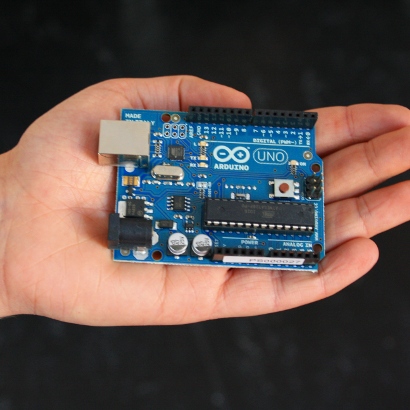
I have been playing around with arduino for a while now and on friday 11th March I had the opportunity to attend an arduino work shop for schools, thanks to Steve Bunce at Vital.
What strikes me about Arduino is the opportunities if offers to link up subjects in the context of CfE. Not only can our learners be offered the opportunity to learn to program, but can get some physical hands on time by building a device, learning about resistors, actuators, transistors, motors and a number of other electrical and mechanical devices. There are even soft Arduino components (such as the Lilypad) that allow learners to build electronic clothing. A quick search on Youtube or Vimeo for Arduino will give you a flavour of the types of projects that can be built.
Make Magazine is a great resource to get some Arduino inspiration and starter tips.
The Consolarium have bought some Arduino starter kits and are working with Braeview Academy in Dundee to see how effective it can be within the curriculum.
As part of the game design work the Consolarium have been carrying out, we often visit subject leaders meetings and are invited to ISIS days to do some CPD with staff. Recently, I visited a group of computing teachers in Ayr to take them through possible uses of BYOB in their Computing courses as a follow on / extension to Scratch. The session was well received and the teachers seemed quite inspired to take BYOB forward in their schools. However, it was perhaps the use of external devices with Scratch or BYOB that really caught their eye.
Scratch 1.4 and BYOB have the ability to interact with external hardware such as Picoboards through the sensor options. However, it’s not just Picoboards that can interact with Scratch.
Lego Wedo
The Lego Wedo sensors and motors can also be used with the sensors. In particular, the LEGO® WeDo™ Robotics Motion Sensor and the LEGO® WeDo™ Robotics Tilt Sensor can be used to detect the outside world. Note - a Lego Power Functions Extension Wire and Lego USB hub are also required.
What’s really interesting about this in terms of the gaming world is that there is potential for pupils to use these sensors to build their own controller for a game - perhaps linking up with Design and Technology / 3D Modelling courses to design and build their own controllers that could house the lego sensors. I demonstrated about this at a Teachmeet last year.
Kinect
Then we come to the Kinect. Yes, the Microsoft Kinect Motion Sensor can be used with Scratch! Stephen Howell took some time to get the Kinect sensor to interact and work with Scratch as an input device. Watch his demo below:
Scratch and Kinect from Stephen Howell on Vimeo.
Find out how to do this on Stephen’s blog. I have used Stephen’s program and was really engaged and excited by it. I think it would make Game Design with Scratch even more attractive and challenging for our learners.
Console Controllers
 If our learners are creating games with Scratch, why not get them to play/control their games with their own console controllers? There are many controller mapping programs available for PC and Mac that will allow users to map their keyboard and mouse presses to a controller. So, if our pupils create a game that uses the arrow keys to move, why not map the arrow keys to the controller allowing the player to use hardware that they are familiar with, that sits within their own cultural domain, to play the game?
If our learners are creating games with Scratch, why not get them to play/control their games with their own console controllers? There are many controller mapping programs available for PC and Mac that will allow users to map their keyboard and mouse presses to a controller. So, if our pupils create a game that uses the arrow keys to move, why not map the arrow keys to the controller allowing the player to use hardware that they are familiar with, that sits within their own cultural domain, to play the game?
Microphone
Finally, what about other modes of control? The sensor blocks in Scratch have a loudness command. Could we challenge our learners to create a game that responds to noise levels? For example, consider this:
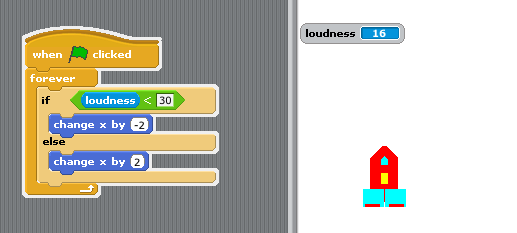
Using the loudness sensor we can control the left / right movement of the rocket.
Overall….
While Scratch and BYOB are not specifically deigned to create games, they are often used for this task as they offer a friendly, easy to use environment. However, by using additional gaming hardware, we can create a learning environment that should hopefully resonate with our pupils and encourage them to engage with the game design process further.
MoreWow! What a response we have had to our Game To Learn afternoon practical workshops! More than half are fully booked and only a few spaces left in the others! As you can see from the table below, we’ve had great interest in our Game Design work shops that focus on Scratch, Build Your Own Blocks, Kodu, RPG Maker VX and 2Simple’s Purple Mash /2DIY as well as Thinkworlds 3D environment building session.
This demonstrates just how keen educators are in Scotland to equip themselves with skills to deliver the Game Design CfE outcomes in their classrooms. What is even more great to see is that it’s not just Computing teachers taking advantage of the sessions, but practioners from all over the curriculum - secondary and primary.
The three sessions that still have spaces in them promise to be an engaging experience for everyone involved.
NB - We will keep you updated via this blog and twitter (follow @gametolearn and the hashtag #gametolearn) should we receive any cancelations or find some more space in any of the full workshops.
|
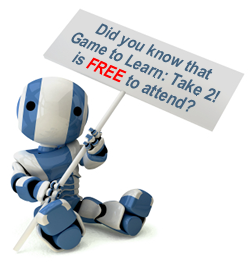 The Consolarium in partnership with JISC are delighted to be bringing the Game To Learn conference to the University of Abertay Dundee on Saturday 19th March.
The Consolarium in partnership with JISC are delighted to be bringing the Game To Learn conference to the University of Abertay Dundee on Saturday 19th March.
The Saturday Programme offers both a fun-packed CPD event for teachers as well as a celebration of the diverse and innovative practice in games-based learning and game design that has been happening in schools across Scotland. Over the past few years the LTS Consolarium initiative has been working with partner schools across Scotland to help nurture the idea that commercially available computer games, that have been developed for entertainment, can be used to help create appealing, purposeful and challenging contexts for learning.
Game Design also offers learners of all ages to engage with the creative process in an engaging and contemprary way that really can facilitate effective CfE delivery. Throughout the morning seminars and afternoon workshops, delegates will have the opportunity to hear from practioners and their use of game design and get some hands on time with game design tools.
Half of the sessions are already fully booked so book your place now to avoid disappointment.
Sessions that are still available include, but not limited to ….
Read about our work with Nintendogs and the Nintendogs case study
Read about our work with the Kinectimals and our Professor Layton case study.
Read about our work with the Eyepet and Gerry’s experiences with Game Based Learning, and others’ experiences in the futurelab report
This may be especially of interest to languages teachers, active school coordinators, PE teachers, class teachers and deputes from Primary and Secondary schools who are interested in seeing how ‘subject specific’ game based learning projects can impact on the whole school.
Read about our work with Just Dance and My French Coach.
Phew! What a start to the day! Follow up your morning seminar with a spot of free lunch, the chance to talk to industry exhibitors then on to a practical, fun filled hands on session. Workshops still available include, but again not limited too..
Using RPG Maker VX to Help Tell Stories & Make Connections Across Learning
Mathew Reid, English Teacher, Garnock Academy, North Ayrshire
“If you’re asking, I’m dancing!” – Join Us for the Just Dance-athon!
Fiona Ferrie, PE Teacher, Doon Academy
Derek Robertson, National Adviser, Consolarium, Learning and Teaching Scotland
Purple Mash: Glow Resources and Game Design with 2DIY
Alan Yeoman, 2Simple Software
Playful, Outdoor and Blended Learning Using GPS
Ollie Bray, National Adviser for Emerging Technologies in Learning, Learning & Teaching Scotland
What are you waitng for? Get your game on now … for FREE!
Hope to see you all on Saturday 19th March 2011
Read Part 1 here
In S3, pupils have a fairly developed knowledge of French and my class has initially enjoyed playing the game and progressing through levels for the first couple of weeks of its used.
They soon needed to be more challenged and felt that the “compare” tool (repeating phrases) was making them feel self aware in front of others in the class.
Pupils were asked to work in pairs in order to create a conversation in French using the My French Coach software. They were invited to choose a topic of their choice and make reference to their consolidated knowledge of French in order to create sentences which were grammatically and structurally correct. Their task was flexible in terms of length, vocabulary, originality, use of humour and props, etc…
Previously, pupils had only practised very short, set up role plays in class on specific topics.
Pupils first familiarised themselves with the phrase book and dictionary tools. Each pair then discussed and agreed on a topic and started constructing their sentences being able to get confident with unknown vocabulary using the “compare tool” in order to learn and practice the pronunciation of their new words.
The phrase book tool offers a variety of topics (such as holidays, greetings, shopping…), most of which haven’t been taught in class.
Below, we can see a short clip of pupils discussing their role play using the DS.
Once the task was completed, pupils were filmed, performing their role play and were asked to assess each other as follows
Pupil A: “It’d be good if the phrase book focussed more on topics studied in French such as school, but the compare tool helps with pronunciation.”
Pupil B: “I enjoyed using the DS and feel it’d be good if there was a voice recognition device where you can record your Standard Grade speaking pieces and it would then be said by a French person!”
I feel this task has been very well received by my pupils. They felt it was something exciting to do and it really raised their confidence in speaking French as well as thinking about their next steps in order to make progress.
During the preparation of their task, pupils needed teacher’s help but a lot less than for other types of writing work. I also felt that pupils were “on task” and developed their social skills without realising: compromising, working as part of a team, listening to others’ views, use of praise and being considerate: “is it ok to use stereotype? Will I offend someone?”
Below is an example of the role plays produced by the pupils.
Finally, we can see the critera chosen, and the feedback given by the pupils.
Read Part 1 here
MoreWhen first playing my French Coach, the user takes a test which sets their initial comprehension of the French language. The player is then placed into a level reflective of their score. A player who scores highly will be able to skip many of the initial levels and more basic concepts.
When starting a lesson, the player is shown ten new words, which include nouns, verbs, adjectives, or adverbs, as well as their meanings and pronunciation.
The software also includes a dictionary and phrase book, complete with audio pronunciations and the facility to record your own pronunciation for comparison purposes.
Hélène Clark, Modern Languages teacher at Firrhill High School in Edinburgh, has used My French Coach with her S1 - S3 classes between September and December 2010. This is the first of 3 blog posts which will document some of her work with pupils using the software.
In S1, pupils have a limited knowledge of French and my classes have enjoyed playing the game and progressing through levels for 15-20 minutes use about twice a week.
Pupils have been keeping a record of their progress at the back of their jotters, reflecting on their learning and noting new words they have learned. This coupled with the individuals user profile on the software allows the pupils to see how they are progressing with the language in a contemporary, familiar way that many of them are used to seeing with their social network profiles and console game profiles. In order to unlock different areas and types of game, pupils must master words. This has proven to be a highly motivating factor.
While the game itself is a useful and motivating tool, Helene used other parts of the software as learning tool. Below is a summary of one of the tasks.
Pupils were asked to work in groups in order to create sentences using prepositions which they had learnt in class: sur, sous, dans, devant, derrière
Previously, pupils were taught how to create sentences using words they had been taught in class eg: Le chat est sur la table.
Each group was then given a photo/drawing (similar to the one below) that had unfamiliar animals, objects and rooms in them.
In groups, pupils used the My French Coach dictionary to inspire them in completing the task,
Pupils were already familiar with the dictionary tool available in the software. They were asked to examine the pictures given to them and construct descriptive sentences, using DS dictionary to find and learn unfamiliar words, including learning the pronunciation of their new words. (using the “compare” tool)
NOTE - One drawback of using the dictionary on the “My French Coach” software is that it does not give the gender of nouns and doesn’t specify if the French word given is a noun, adverb or verb. Therefore, a broader understanding of the language is necessary and S1 pupils needed to use a “paper dictionary” in order to find the gender: masculine (le) / feminine (la)
When asked about the task, pupils felt assertive about expressing their opinions:
Pupil A: “the software is very useful but it should be changed so that we can see the gender”
Pupil B: “Looking up words on the DS is fast and easier than a paper dictionary”
Pupil C: “Some words aren’t on the DS dictionary”
Pupil D: “The DS tells you how to pronounce words and makes me happier to talk French”
I started using the Nintendo DS consoles in August 2010, at the beginning of the new school year. I didn’t know my S1 students. The first thing I noticed is that using the Nintendo DS has helped me establish a strong, positive relationship with my new classes very quickly. The mention of the project created motivation, excitement and engagement with technology relevant to pupils.
The initial test and progressing through levels lead naturally to peer evaluation, informal discussions, bonding of class members, meaningful reward in the context of the game and meeting each student’s needs – for example:
A lower attaining ADHD pupil, who can be quite restless, started at level 1 after his initial test. He felt frustrated, knew very little French but was engaged and motivated to learn with the DS. Progressing through levels was very meaningful to him. As a result, he has made incredible progress. He may spend 20 minutes to produce 3 French sentences but he thinks thoroughly about the structure of the language and always tries to achieve his full potential. He also learns his vocabulary after each lesson as he has understood the importance of building on his own knowledge. In class, he is always positive, calm and hardworking despite his condition.
A very able, slightly over confident pupil started at level 12 after his initial test. He started by showing off to the rest of the class which didn’t make him very popular in class discussions. However, he soon realised that it was very difficult for him to progress through the levels as the game gets more challenging. He also realised that he was often rushing his work and was missing on important information or making various mistakes from grammar, spelling or structure. His attitude has now changed as he is being more conscientious on his DS or class work. He also often offers to support other pupils, using his own ability and mistakes to helping others in the class. His relationship with the rest of the class is also more positive.
I believe using the game as one tool in my classroom, has helped create an engaging climate for learning for all pupils. I have observed my pupils demonstrating the 4 capacities of Curriculum for Excellence: successful learner, confident individual, responsible citizen and effective contributor.
You can contact Hélène at [email protected]
Read Part 2 here
More
Find us on